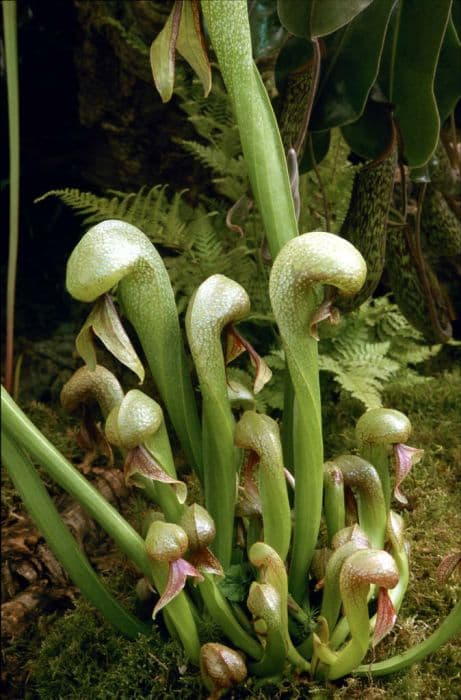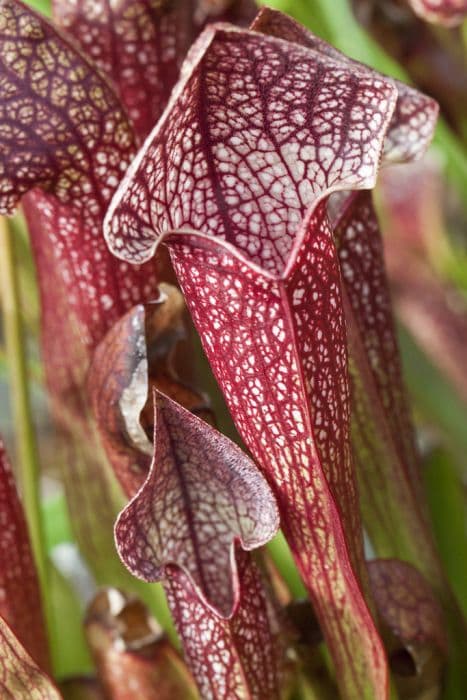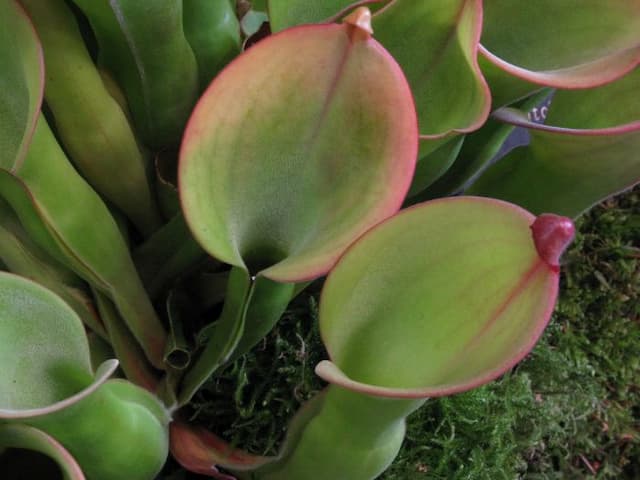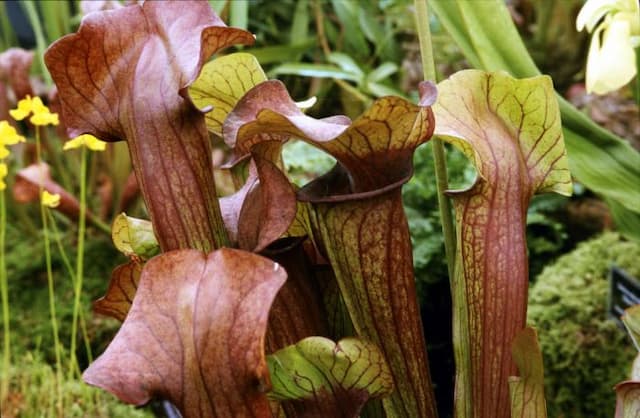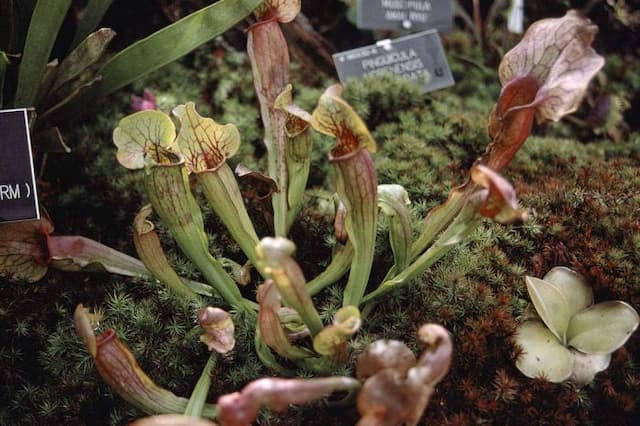Pitcher Plant Sarracenia 'Juthatip Soper'

ABOUT
Sarracenia 'Juthatip Soper', commonly known as the pitcher plant, has a distinctive appearance characterized by its tubular, pitcher-like leaves that are evolved to trap and digest insects. These modified leaves are typically vibrant with a combination of colors such as deep reds, purples, and greens which often create striking patterns. The upper portion of the pitchers, called the hood, arches over the opening to prevent rain from diluting the digestive fluids inside. Small hairs inside the pitchers point downwards, making it difficult for trapped prey to escape. Its flowers, which emerge separately, are also quite showy and unusual, usually taking on umbrella-like shapes sometimes complementing the foliage with their own dramatic coloration that can attract a range of pollinators. Overall, the visual appeal of the pitcher plant lies in its carnivorous nature and the ornate beauty of its leaf and flower structures, making it a unique and intriguing addition to gardens or collections of exotic plants.
About this plant
 Names
NamesFamily
Sarraceniaceae.
Synonyms
Juthatip Soper Pitcher Plant, Soper's Pitcher, Juthatip Soper American Pitcher Plant.
Common names
Sarracenia 'Juthatip Soper'
 Toxicity
ToxicityTo humans
The Sarracenia 'Juthatip Soper' commonly known as the pitcher plant, is not considered poisonous to humans. There are generally no toxic effects from touching or ingesting the plant. Handling the plant does not result in any significant risk of toxicity. However, consuming any part of the plant is not advisable as it is not intended for human consumption and could potentially cause stomach discomfort or an allergic reaction in sensitive individuals.
To pets
The pitcher plant is not known to be toxic to pets. There is typically no danger in pets coming into contact with the Sarracenia 'Juthatip Soper'. While the plant is not intended for consumption by animals, ingestion is unlikely to cause poisoning. Nevertheless, it is always best to prevent pets from eating ornamental plants as they can cause gastrointestinal upset or an unexpected allergic reaction.
 Characteristics
CharacteristicsLife cycle
Perennials
Foliage type
Semi-deciduous
Color of leaves
Varies
Flower color
Pink
Height
1-2 feet (30-60 cm)
Spread
1-2 feet (30-60 cm)
Plant type
Herb
Hardiness zones
5
Native area
North America
Benefits
 General Benefits
General Benefits- Attracts Pollinators: The Sarracenia 'Juthatip Soper' produces flowers that can attract bees and other beneficial insects, aiding in the pollination of nearby plants.
- Natural Pest Control: As a carnivorous plant, it helps control pest populations by capturing and consuming insects such as flies and mosquitoes.
- Education and Interest: This plant can be used for educational purposes, showcasing plant diversity and unusual feeding strategies to both children and adults.
- Garden Aesthetics: With its unique pitcher-shaped leaves and striking coloration, it can enhance the visual appeal of gardens and natural landscapes.
- Conservation: By cultivating Sarracenia 'Juthatip Soper', enthusiasts can help preserve this cultivar and contribute to the conservation of carnivorous plant species.
- Habitat for Insects: While carnivorous, this plant can also provide a microhabitat for insects, some of which may coexist with it symbiotically.
- Soil Improvement: By decomposing captured insects, the plant can contribute to soil enrichment with nutrients that are otherwise hard to obtain in their native poor-soil habitats.
 Medical Properties
Medical PropertiesThis plant is not used for medical purposes.
 Air-purifying Qualities
Air-purifying QualitiesThis plant is not specifically known for air purifying qualities.
 Other Uses
Other Uses- Educational Tool: The pitcher plant can be utilized in educational settings to demonstrate unique adaptations and evolutionary strategies in plants for survival and nutrient acquisition.
- Art Inspiration: Artists may draw inspiration from the Sarracenia 'Juthatip Soper' for a variety of artworks, including painting, sculpture, and even fashion design, due to its unique shape and colors.
- Photography: The plant is a popular subject for photographers, especially those interested in macro photography, due to its intricate design and interesting insect-trapping mechanism.
- Carnivorous Plant Collections: Hobbyists and collectors of carnivorous plants often seek out Sarracenia 'Juthatip Soper' to add to their collections for display purposes.
- Science Projects: Students might use the pitcher plant to conduct experiments on insect behavior or investigate how the plant digests its prey.
- Thematic Gardens: This pitcher plant can be incorporated into thematic gardens, such as 'Alice in Wonderland' or other fantasy-themed gardens for its otherworldly appearance.
- Decorative Water Features: The plant can add an exotic flair to water features in botanical gardens or private ponds, as it naturally grows in wetlands.
- Compost Accelerator: Dead pitcher plants can be added to compost piles where they might help accelerate the composting process due to the enzymes they contain.
- Eco-friendly Pest Control: Pitcher plants can be used as a natural method to reduce flying insect populations in greenhouses or gardens without the use of chemicals.
- Horticultural Shows: They can serve as the centerpiece in plant competitions and horticultural shows because of their striking appearance and rarity in cultivation.
Interesting Facts
 Feng Shui
Feng ShuiThe Pitcher Plant is not used in Feng Shui practice.
 Zodiac Sign Compitability
Zodiac Sign CompitabilityThe Pitcher Plant is not used in astrology practice.
 Plant Symbolism
Plant Symbolism- Uniqueness: The Sarracenia 'Juthatip Soper' is a unique hybrid of pitcher plants, symbolizing the beauty and value found in uniqueness and individuality.
- Adaptation: As a carnivorous plant that has adapted to nutrient-poor environments, it symbolizes one's ability to adapt and thrive in difficult conditions.
- Mystery: The plant's unusual appearance and carnivorous nature can symbolize mystery and the unknown, as it deviates from common perceptions of how plants sustain themselves.
- Attraction: The pitcher plant attracts insects not only for nutrients but also for pollination, which can symbolize allure and the idea that what draws us in isn't always what is best for us.
- Balance: It symbolizes balance in ecosystems, as it plays a role in controlling insect populations and demonstrates the delicate interplay within nature.
 Water
WaterPitcher plants like the Sarracenia 'Juthatip Soper' require constant moisture and prefer standing water. They should be watered frequently with rainwater or distilled water to keep the soil damp but not waterlogged. Water them by filling the tray method, where water is poured into a saucer beneath the pot, to a depth of about one to two inches. Allow them to absorb water from the bottom to mimic their natural boggy habitat. During their growing season, in spring and summer, they may need water every two to three days, depending on the climate. Ensure the water in the tray does not run completely dry, adding more water to maintain the level as needed.
 Light
LightPitcher plants such as the Sarracenia 'Juthatip Soper' thrive in full sunlight. They should be placed in a spot where they receive at least six to eight hours of direct sunlight per day. A south-facing window or an unobstructed outdoor area that gets ample sunlight is ideal for these plants. Avoid placing them in shaded or low-light environments, as insufficient light can hinder their growth and reduce their ability to produce the characteristic pitchers.
 Temperature
TemperatureThe Pitcher plant Sarracenia 'Juthatip Soper' prefers a temperature range of 70 to 85 degrees Fahrenheit during the growing season. They can tolerate temperatures as low as 20 degrees Fahrenheit in winter dormancy but should not be exposed to prolonged temperatures below freezing. The ideal growing conditions mimic a temperate climate with cool winters to allow the plant to go dormant properly, which is crucial for its health.
 Pruning
PruningPruning the Pitcher plant, Sarracenia 'Juthatip Soper', involves removing dead or faded pitchers and flowers to promote new growth and prevent rot. This should be done after the dormant period, usually in early spring, cutting the dead growth at the base. Pruning can be done annually, as pitchers typically last a season before withering. Remember to use sterile tools to avoid transferring any pathogens to the plant.
 Cleaning
CleaningAs needed
 Soil
SoilThe best soil mix for the Pitcher Plant (Sarracenia 'Juthatip Soper') is a combination of sphagnum peat moss and perlite or sand in a 1:1 ratio. The soil pH should be acidic, between 4.0 and 5.0.
 Repotting
RepottingThe Pitcher Plant should be repotted about every two to three years to refresh the soil and accommodate growth.
 Humidity & Misting
Humidity & MistingThe Pitcher Plant thrives in high humidity conditions, ideally between 60% and 80%.
 Suitable locations
Suitable locationsIndoor
Place in bright light, keep soil moist, high humidity.
Outdoor
Full sun to partial shade, keep moist, protect from frost.
Hardiness zone
6-8 USDA
 Life cycle
Life cycleThe Sarracenia 'Juthatip Soper', also known as the pitcher plant, starts its life cycle as a seed which germinates in moist, warm conditions often in spring. The seedling develops a small, rosette-like base with juvenile pitchers beginning to form as the plant matures. As it grows, the plant produces larger and more complex pitchers each season, adapted to attract and trap insects for nutrition. During the active growing seasons, typically spring to early fall, the plant goes through a phase of vegetative growth and pitcher development, possibly flowering in spring if mature enough. After pollination, the flowers can produce seeds, continuing the reproductive cycle. During winter or cooler months, the pitcher plant enters dormancy, reducing its metabolic activity until conditions are favorable again for growth.
 Propogation
PropogationPropogation time
Spring-Early Summer
The most popular method of propagation for the Sarracenia 'Juthatip Soper', commonly known as the Pitcher Plant, is through division. This process typically takes place in late winter to early spring before the plant enters its active growing phase. To propagate by division, remove the plant from its pot and gently separate the rhizomes, ensuring that each division has at least one growing point or pitcher. Replant the divisions in a peat-based soil mix, keeping the soil moist but not waterlogged. Place the pots in a location with bright, indirect light and maintain a high humidity level around the plants to help ease the stress of transplantation. With proper care, the divisions will soon establish themselves and begin to grow new pitchers.
